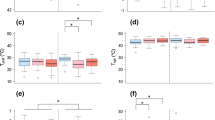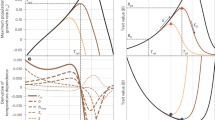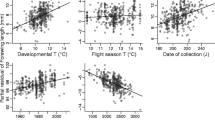Abstract
Climate-change induced shifts in species’ temporal and geographic niches have been well documented, while plastic and genetic responses to climatic change have received much less attention. Plastic responses to changes in temperature are generally well understood, though most experimental studies to date have used constant temperature regimes, the reliability of which is under debate. We here investigate plastic responses in the widespread butterfly Pieris napi to simulated climate change, using ecologically realistic diurnal temperature cycles and current and predicted temperature regimes including effects of a heat wave. Increasing the temperature mean by 3 °C predominantly affected developmental times, cold resistance and adult life span, while an increase in the diurnal temperature amplitude had very little effects. Immune function responded only weakly to different thermal regimes. The simulation of a prolonged heat wave severely impaired juvenile survival, body size and longevity, supporting the wide-held notion that extreme weather events will be much more important for species’ performance and local survival than moderate increases in temperature means. Given that the frequency of extreme weather events is predicted to increase with climate change, even widespread species may be negatively affected.



Similar content being viewed by others
References
Altermatt F (2011) Climatic warming increases voltinism in European butterflies and moths. Proc R Soc B 277:1281–1287
Angilletta MJ Jr (2009) Thermal adaptation. A theoretical and empirical synthesis. Oxford University Press, New York
Bauerfeind SS, Perlick JEC, Fischer K (2009) Disentangling environmental effects on adult life span in a butterfly across the metamorphic boundary. Exp Gerontol 44:805–811
Bergström J, Wiklund C (2002) Effects of size and nuptial gifts on butterfly reproduction: can females compensate for a smaller size through male-derived nutrients? Behav Ecol Sociobiol 52:296–302
Berwaerts K, Van Dyck H (2004) Take-off performance under optimal and suboptimal thermal conditions in the butterfly Pararge aegeria. Oecologia 141:536–545
Bonnemaison L (1965) Insect pests of crucifers and their control. Annu Rev Entomol 10:233–256
Bozinovic F, Bastías DA, Boher F, Clavijo-Baquet S, Estay SA, Angilletta MJ Jr (2011) The mean and variance of environmental temperature interact to determine physiological tolerance and fitness. Physiol Biochem Zool 84:543–552
Bradford MM (1976) A rapid and sensitive method for the quantitation of microgram quantities of protein utilizing the principle of protein-dye binding. Anal Biochem 72:248–254
Buckley LB, Kingsolver JG (2012) The demographic impacts of shifts in climate means and extremes on alpine butterflies. Funct Ecol 26:969–977
Chen CP, Denlinger DL (1992) Reduction of cold injury in flies using an intermittent pulse of high temperature. Cryobiology 29:138–143
Chown SL, Hoffmann AA, Kristensen TN, Angilletta MJ Jr, Stenseth NC, Pertoldi C (2010) Adapting to climate change: a perspective from evolutionary physiology. Clim Res 43:3–15
Easterling DR, Meehl GA, Parmesan C, Changon SA, Karl TR, Mearns LO (2000) Climate extremes: observations, modeling, and impacts. Science 289:2068–2074
Ebert G, Rennwald E (1993) Die Schmetterlinge Baden-Württembergs. Vol 1: Tagfalter 1. Eugen Ulmer GmbH & Co., Stuttgart (in German)
Fagerström T, Wiklund C (1982) Why do males emerge before females? Protandry as a mating strategy in male and female butterflies. Oecologia 52:164–166
Feder ME, Garland T Jr, Marden JH, Zera AJ (2010) Locomotion in response to shifting climate zones: not so fast. Annu Rev Physiol 72:167–190
Ferkau C, Fischer K (2006) Costs of reproduction in male Bicyclus anynana and Pieris napi butterflies: effects of mating history and food limitation. Ethology 112:1117–1127
Fierst JL (2011) A history of phenotypic plasticity accelerates adaptation to a new environment. J Evol Biol 24:1992–2001
Fischer K, Fiedler K (2001) Effects of adult feeding and temperature regime on fecundity and longevity in the butterfly Lycaena hippothoe (Lycaenidae). J Lepid Soc 54:91–95
Fischer K, Brakefield PM, Zwaan BJ (2003) Plasticity in butterfly egg size: why larger offspring at lower temperatures? Ecology 84:3138–3147
Fischer K, Dierks A, Geister TL, Liszka M, Winter S, Pflicke C (2010) Environmental effects on temperature stress resistance in the tropical butterfly Bicyclus anynana. PLoS One 5:e15284
Fischer K, Kölzow N, Höltje H, Karl I (2011) Assay conditions in laboratory experiments: is the use of constant rather than fluctuating temperatures justified when investigating temperature-induced plasticity? Oecologia 166:23–33
Folguera G, Bastías DA, Bozinovic F (2009) Impact of experimental thermal amplitude on ectotherm performance: adaptation to climate change variability? Comp Biochem Phys A 154:389–393
Folguera G, Bastías DA, Caers J, Rojas JM, Piulachs M, Bellés X, Bozinovic F (2011) An experimental test of the role of environmental temperature variability on ectotherm molecular, physiological and life-history traits: implications for global warming. Comp Biochem Phys A 159:242–246
Geister TL, Fischer K (2007) Testing the beneficial acclimation hypothesis: temperature effects on mating success in a butterfly. Behav Ecol 18:658–664
German Weather Service (Deutscher Wetterdienst) (2011) Federal Ministry of Transport, Building and Urban Development, Germany, Offenbach (in German). http://www.dwd.de
Hansen J, Sato M, Ruedy R, Lo K, Lea DW, Medina-Elizade M (2006) Global temperature change. Proc Natl Acad Sci USA 103:14288–14293
Hegland SJ, Nielsen A, Lázaro A, Bjerknes A-L, Totland Ø (2009) How does climate warming affect plant-pollinator interactions? Ecol Lett 12:184–195
Hoffmann AA, Anderson A, Hallas R (2002) Opposing clines for high and low temperature resistance in Drosophila melanogaster. Ecol Lett 5:614–618
Hoffmann AA, Sørensen JG, Loeschcke V (2003) Adaptation of Drosophila to temperature extremes: bringing together quantitative and molecular approaches. J Therm Biol 28:175–216
Hofmann GE, Todgham AE (2010) Living in the now: physiological mechanisms to tolerate a rapidly changing environment. Annu Rev Physiol 72:127–145
IPCC Intergovernmental Panel on Climate Change (2007) Summary for policymakers. In: Solomon S, Qin D, Manning M, Chen Z, Marquis M (eds) Climate Change 2007: the physical science basis. Contribution of working group I to the fourth assessment report of the intergovernmental panel on climate change. Cambridge University Press, Cambridge, pp 1–18
Janowitz SA, Fischer K (2011) Opposing effects of heat stress on male versus female reproductive success in Bicyclus anynana butterflies. J Therm Biol 36:283–287
Juroszek P, von Tiedemann A (2013) Plant pathogens, insect pests and weeds in a changing global climate: a review of approaches, challenges, research gaps, key studies and concepts. J Agric Sci 151:163–188
Karl I, Stoks R, De Block M, Janowitz SA, Fischer K (2011) Temperature extremes and butterfly fitness: conflicting evidence from life history and immune function. Global Change Biol 17:676–687
Kingsolver JG, Ragland GJ, Diamond SE (2008) Evolution in a constant environment: thermal fluctuations and thermal sensitivity of laboratory and field populations of Manduca sexta. Evolution 63:537–541
Kurtz J, Sauer KP (2001) Gender differences in phenoloxidase activity of Panorpa vulgaris hemocytes. J Invertebr Pathol 78:53–55
Li HB, Shi L, Lu MX, Wang JJ, Du YZ (2011) Thermal tolerance of Frankliniella occidentalis: effects of temperature, exposure time, and gender. J Therm Biol 36:437–442
Martin LB, Hopkins WA, Mydlarz LD, Rohr JR (2010) The effects of anthropogenic global changes on immune functions and disease resistance. Ann N Y Acad Sci 1195:129–148
McGuinness KA (2002) Of rowing boats, ocean liners and tests of the ANOVA homogeneity of variance assumption. Austral Ecol 27:681–688
Mitchell KA, Sgrò CM, Hoffmann AA (2010) Phenotypic plasticity in upper thermal limits is weakly related to Drosophila species distributions. Funct Ecol 25:661–670
Murdock CC, Paaijmans KP, Cox Foster D, Read AF, Thomas MB (2012a) Rethinking vector immunology: the role of environmental temperature in shaping resistance. Nat Rev Microbiol 10:869–876
Murdock CC, Paaijmans KP, Bell AS, King JG, Hillyer JF, Read AF, Thomas MB (2012b) Complex effects of temperature on mosquito immune function. Proc R Soc B 279:3357–3366
Niehaus AC, Angilletta MJ Jr, Sears MW, Franklin CE, Wilson RS (2012) Predicting the physiological performance of ectotherms in fluctuating thermal environments. J Exp Biol 215:694–701
Nyamukondiwa C, Terblanche JS, Marshall KE, Sinclair BJ (2011) Basal cold but not heat tolerance constrains plasticity among Drosophila species (Diptera: Drosophilidae). J Evol Biol 24:1927–1938
Parmesan C, Root TL, Willig MR (2000) Impacts of extreme weather and climate on terrestrial biota. B Am Meteorol Soc 81:443–450
Petavy G, David JR, Gibert P, Moreteau B (2001) Viability and rate of development at different temperatures in Drosophila: a comparison of constant and alternating regimes. J Therm Biol 26:29–39
Pijpe J, Brakefield PM, Zwaan BJ (2007) Phenotypic plasticity of starvation resistance in the butterfly Bicyclus anynana. Evol Ecol 21:589–600
Polley L, Thompson RCA (2009) Parasite zoonoses and climate change: molecular tools for tracking shifting boundaries. Trends Parasitol 25:285–291
Rohr JR, Dobson AP, Johnson PTJ, Kilpatrick AM, Paull SH, Raffel TR, Ruiz-Moreno D, Thomas MB (2011) Frontiers in climate change—disease research. Trends Ecol Evol 26:270–277
Rolff J, Van de Meutter F, Stoks R (2004) Time constraints decouple age and size at maturity and physiological traits. Am Nat 64:559–565
Santos M, Castañeda LE, Rezende EL (2011) Making sense of heat tolerance estimates in ectotherms: lessons from Drosophila. Funct Ecol 25:1169–1180
Schulte PM, Healy TM, Fangue NA (2011) Thermal performance curves, phenotypic plasticity, and the time scales of temperature exposure. Integr Comp Biol 51:691–702
Sørensen JG, Kristensen TN, Kristensen KV, Loeschcke V (2007) Sex specific effects of heat induced hormesis in Hsf-deficient Drosophila melanogaster. Exp Gerontol 42:1123–1129
StatSoft Inc. (2007) Statistica for Windows. Version 8.0. Tulsa, USA
Stoks R, De Block M, Slos S, Van Doorslaer W, Rolff J (2006) Time constraints mediate predator-induced plasticity in immune function, condition, and life history. Ecology 87:809–815
Terblanche JS, Nyamukondiwa C, Kleynhans E (2010) Thermal variability alters climatic stress resistance and plastic responses in a globally invasive pest, the Mediterranean fruit fly (Ceratitis capitata). Entomol Exp Appl 137:304–315
Thomas MB, Blanford S (2003) Thermal biology in insect-parasite interactions. Trends Ecol Evol 18:344–350
Triggs A, Knell RJ (2012) Interactions between environmental variables determine immunity in the Indian meal moth Plodia interpunctella. J Anim Ecol 81:386–394
Tylianakis JM, Didham RK, Bascompte J, Wardle DA (2008) Global change and species interactions in terrestrial ecosystems. Ecol Lett 11:1351–1363
Van der Putten WH, Macel M, Visser ME (2010) Predicting species distribution and abundance responses to climate change: why it is essential to include biotic interactions across trophic levels. Philos Trans R Soc B Biol Sci 365:1025–2034
Visser ME (2008) Keeping up with a warming world: assessing the rate of adaptation to climate change. Proc R Soc B 275:649–659
WallisDeVries MF, Baxter W, Van Vliet AJH (2011) Beyond climate envelopes: effects of weather on regional population trends in butterflies. Oecologia 167:559–571
Walther G-R (2010) Community and ecosystem responses to recent climate change. Philos Trans R Soc B Biol Sci 365:2019–2024
Walther G-R, Post E, Convey P, Menzel A, Parmesan C, Beebee TJC, Fromentin J-M, Hoegh-Guldberg O, Bairlein F (2002) Ecological responses to recent climate change. Nature 416:389–395
Wang XG, Johnson MW, Daane KM, Nadel H (2009) High summer temperatures affect the survival and reproduction of olive fruit fly (Diptera: Tephritidae). Physiol Entomol 38:1496–1504
Wiklund C, Kaitala A (1995) Sexual selection for large male size in a polyandrous butterfly: the effect of body size on male versus female reproductive success in Pieris napi. Behav Ecol 6:6–13
Acknowledgments
We thank Christin Park for assistance in the analyses of immune parameters and two anonymous reviewers for helpful comments on the manuscript.
Author information
Authors and Affiliations
Corresponding author
Rights and permissions
About this article
Cite this article
Bauerfeind, S.S., Fischer, K. Simulating climate change: temperature extremes but not means diminish performance in a widespread butterfly. Popul Ecol 56, 239–250 (2014). https://doi.org/10.1007/s10144-013-0409-y
Received:
Accepted:
Published:
Issue Date:
DOI: https://doi.org/10.1007/s10144-013-0409-y




